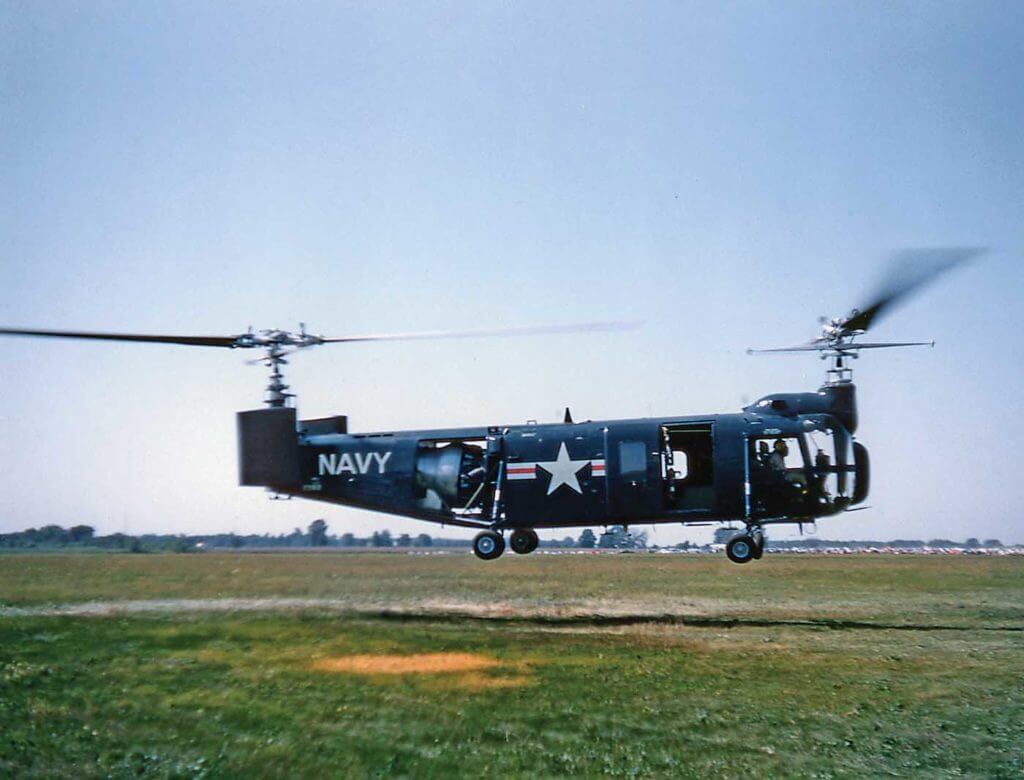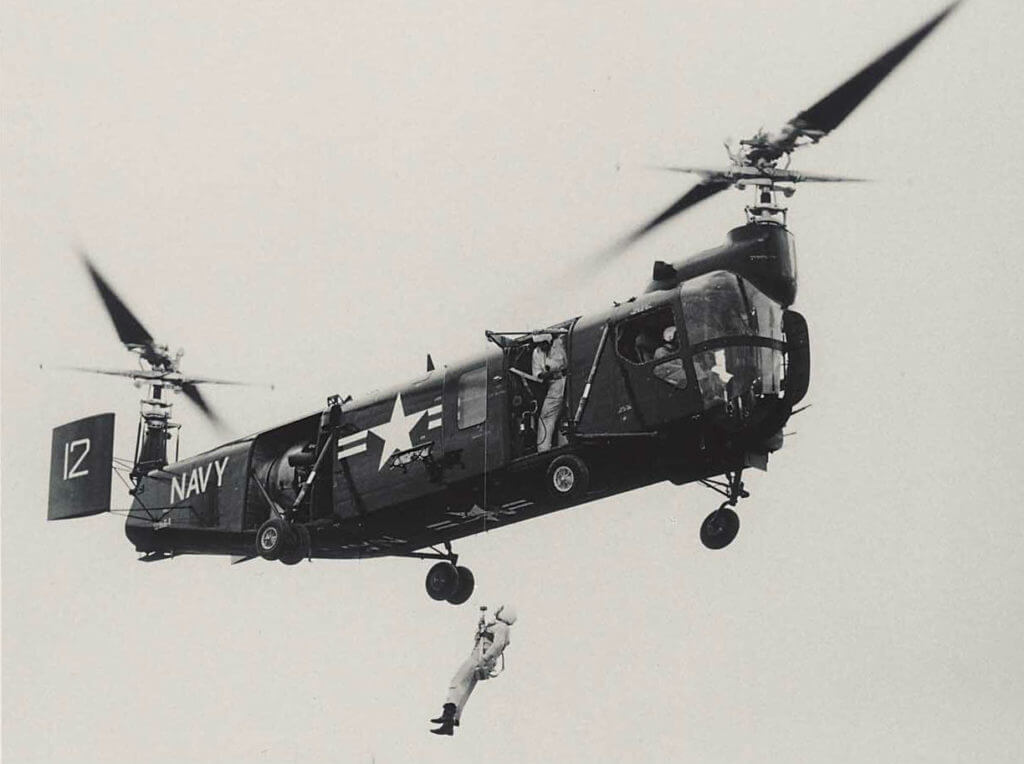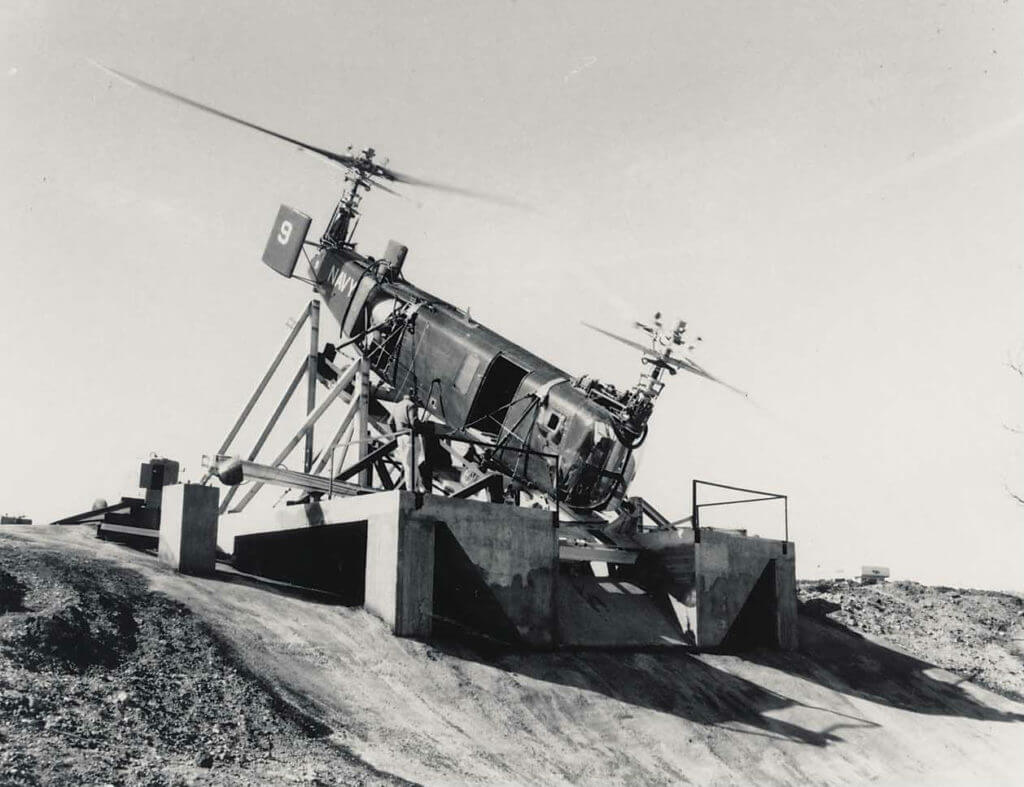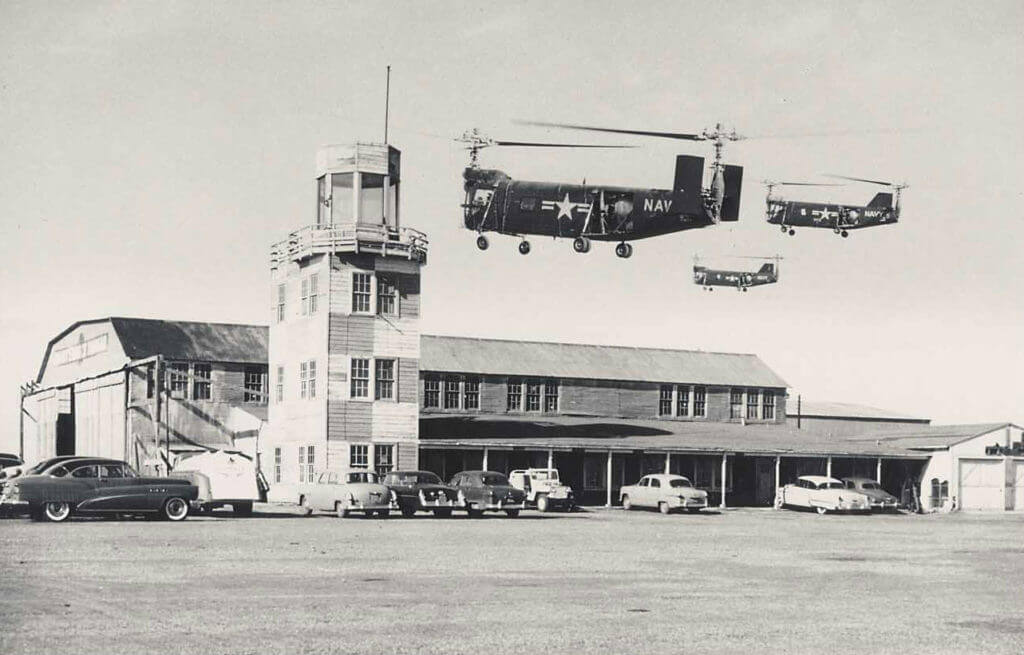Ask someone to name a tandem-rotor heavy-lift helicopter, and it’s likely the response will include the name Boeing. From the CH-46 Sea Knight and CH-47 Chinook, to the Vertol 107-II and Model 234, Boeing has dominated the tandem-rotor military and civilian markets ever since it entered them with the acquisition of Vertol (previously known as Piasecki) in 1960. But in the early development of tandem-rotor aircraft, there were several manufacturers vying for success with their own designs. For a brief period, Bell Aircraft Company (now known as Bell Flight) was among them.

While Bell has made a substantial contribution to the development of tiltrotor technology over the decades, its involvement in tandem-rotor aircraft spanned just one type — the Model 61. The aircraft, which first flew in March 1953, represented Bell’s first departure from the single-rotor helicopter design it had produced since 1942. It also became the first helicopter specifically designed for anti-submarine warfare, and was designated the HSL-1 by the U.S. Navy (the “H” stood for helicopter, “S” for anti-submarine warfare, and “L” for Bell Aircraft).
It was developed to combat the perceived threat of the Soviet Union’s submarine fleet, which had been growing rapidly since the end of World War II. By the end of the 1940s, the U.S. military had become concerned that its existing aircraft and ships were no longer sufficiently able to detect and destroy submarines. To fill this perceived gap in capability, the U.S. Navy envisioned a new fleet of helicopters that had the endurance to fly long missions away from its ships, and the ability to carry much heavier loads off its aircraft carriers than possible with its existing fleet.
The need for an anti-submarine helicopter
Helicopters had, of course, made a limited appearance during the latter years of World War II (in the form of the Sikorsky R-4, R-5 and R-6 on the U.S. side), but they weren’t specifically used for anti-submarine work. In April 1945, as the war reached its last few months, the U.S. Coast Guard (USCG) took the first steps to gauging the helicopter’s ability to perform this role, experimenting with a Sikorsky R-6 (designated the HO5 by the USCG) carrying a sonar dome and reel underneath. The trials had limited success. Later, a larger Sikorsky R-5 (HO2S) with an improved sonar and reel was used more successfully in tests in Long Island Sound, New York, and down in Key West, Florida, during 1946.
Further experimental sonar trials began in 1948 using a tandem-rotor Piasecki PV-3 (HRP-1) in Key West. Very high temperatures and problems with the sonar hampered the tests, and during November 1949, one of the HRP-1s crashed into the water. Further sonar trials were conducted using Sikorsky S-55s (HO4S-1s), U.S. Marine Corps Piasecki HRP-1s, and Navy tandem-rotor Piasecki PD-18s (HUPs). Unfortunately, they all failed to produce the required performance for an anti-submarine mission, with insufficient engine power and cooling concerns for operations in high temperatures and humidity.

Following these trials, the Navy issued a request for proposals in January 1950 for a new anti-submarine warfare helicopter. The Navy was looking for an improved, larger, more powerful helicopter, capable of not only detecting and destroying submarines, but also of being used for air sea rescue, transport duties, reconnaissance and patrols, and other related naval missions.
By April, 12 companies had bid on the contract, including Bell, Curtis-Wright/Doman, Gyrodyne, Hughes, Kellett, McDonnell, Piasecki, Sikorsky, Hiller, and several small companies that had never even built a helicopter before. In June 1950, the Bell Aircraft Company’s submission was named the winner. This was a real surprise to Frank Piasecki, as his company was the only manufacturer of tandem helicopters in the U.S. at the time.
Building a submarine hunter
The primary job of the Model 61/HSL-1 was to detect, identify, track and/or destroy enemy submarines. It was designed to operate from ships in all weather conditions, and was expected to be used in both a search and an attack role, with two aircraft working in tandem. The HSL-1 was equipped with dipping sonar for tracking, and was capable of carrying both torpedoes and missiles when required to attack.
The HSL-1 was powered by the proven Pratt & Whitney R-2800-50 radial 2,400-shaft-horsepower engine, which was mounted in the aft of the aircraft. This drove a transmission shaft to the front pylon. Attached to each end of the HSL-1’s large airframe was a classic two-blade main rotor with a stabilizing bar (as on the Bell 47), which gave the aircraft an overall rotor diameter of 51 feet and 6 inches (15.7 meters). Underneath was a four-wheel undercarriage.
Including the sonar equipment, the HSL-1 weighed 26,500 pounds (12,020 kilograms). It was designed to operate with a crew of four (a pilot, co-pilot, and two sonar operators), and was the largest four-person helicopter Bell had designed to that point. The aircraft had a cruising speed of 98 m.p.h. (161 km/h), and a range of 350 miles (563 kilometers).

The challenge for Bell and its engineers over the next few years would be to bring it into production alongside the Bell 47 line.
A full-size mock-up of the HSL-1 was completed by early 1951 at the Bell plant in Niagara Falls, New York, and this was quickly followed by three prototype XHSL-1 airframes manufactured at its Buffalo, New York, facility. It was about this time that company president Larry Bell decided to move his helicopter operations from Niagara Falls to a new facility in Hurst, Texas. The HSL-1 airframes were shipped to the new plant by rail in late 1951.
The first prototype started ground runs in April 1952, and by December that year, the program had begun taxi test runs. The noise and vibration in the cockpit was particularly noticeable. The first hovering flight, with chief pilot Floyd Carlson and Joe Dunne at the controls, took place at the Amon Carter airport east of Hurst on March 3, 1953.
Flying continued throughout the year, with Bell’s engineers gradually improving and correcting the HSL-1’s initial problems with low speed and hovering. By December 1953, three aircraft were flying in the air together at Hicks Field, northwest of the Hurst plant. The next month, Dunne and Bill Quinlan flew an HSL-1 700 miles to Elgin Air Force Base in Florida for climatic testing.
A troubled development
Around this time, Bell received an order for 78 HSL-1 helicopters for the U.S. Navy. Of these, 18 HSL-1 helicopters were to go to the British Royal Navy.
In early 1954, Bell developed an autopilot system for the HSL-1. Ship 4 — the first production HSL-1 — was used to qualify the autopilot when using the dipping sonar while hovering during search missions. Testing took place on a lake northwest of the Hurst plant, and the autopilot was a complete success.

Another major success for the program was the development of autorotation techniques, due to the helicopter’s high inertia rotors. The testing was completed by Bell test pilot Elton Smith.
However, by mid-1954, it was apparent the overall HSL program was in trouble. Only three production HSL-1s had been built to date, and those were being used by Bell for development work. Maneuvering of the HSL-1 was restricted to a diving speed of 100 knots, the angle of bank could not exceed 45 degrees, and the flight controls were not to be moved abruptly. The Navy felt the program was not moving along as they had expected, and cancellation was a possibility. They decided to wait until the Naval Air Test Center (NATC) evaluations and demonstrations had been completed before making any decisions on the program’s future.
Bell delivered its first HSL-1 (ship 6) to the Navy in August 1954, for ferry to the naval test center at Patuxent River, Maryland. Two more HSL-1s followed in late August for service test.
Later that year, the program suffered the loss of an aircraft, when an HSL-1 crashed near the Bell Globe plant north of Fort Worth. The front rotor hit the ground after the ship pitched down, destroying the aircraft, but thankfully all the crew survived.
In February 1955, a Navy HSL-1 (ship 9) was used on a tow testing mission at Corpus Christi, Texas. The aircraft pulled loads at sea, at the end of a 600-foot cable. The tests proved to be successful.

Carrier trials took place aboard the Kula Gulf in March 1955, with the three test center HSL-1s. Flight availability was excellent over the eight days of the trials, but blade folding proved to be a very labor intensive and cumbersome task, and the size of the helicopter made for a tight fit on the elevator deck. Overall, the HSL-1 performed satisfactorily, and it appeared that the Navy was planning to continue operationally with the HSL-1. By now, Bell was delivering four of the type each month.
In April 1955, ship 13 crashed during a Navy acceptance flight at the Hurst plant, killing one pilot and badly burning the other. The helicopter’s nose suddenly dipped during a low hover, resulting in the front main rotor hitting the ground. The aircraft caught fire in the resulting crash.
The HSL-1’s introduction into the Navy fleet was held up and then canceled altogether. In July 1955, the Navy officially terminated HSL production after 50 ships were built. None of the HSL-1s were ever used operationally by the U.S. Navy.
Finding a new home for the HSL-1
The HSL-1 termination was a real blow for Bell. Deliveries of the aircraft slowed down until early 1956, with others delivered in the fall. Many were ferried to naval air stations in Arizona, California, and Virginia and put straight into storage where they were stricken off, never to fly again.
In 1956, Bell pilot Dick Stansbury demonstrated one HSL-1 to the U.S. Army at Fort Rucker, Alabama. Unfortunately, there was little interest and Bell received no orders from the Army. Bell came up with the D216 proposal — a three-engine turbine version of a larger Model 61 — for civil use. They contacted New York Airways, but again, there was no interest from them or other commercial operators.

Five HSL-1s were taken out of storage and used in a Navy
minesweeping program from March 1957 to late November 1959 in Panama City, Florida. The last production HSL-1 was kept at Bell until 1959, when it was used on a small Navy contract to test stability improvements. It eventually ended up in San Diego, California, at naval air station North Island.
A HSL-1 helicopter was reported to have been shipped by rail to Fort Rucker in 1960 for display at the Army Aviation Museum. But, as it was not an Army helicopter, the museum was not interested in it. The HSL-1 ended up in an aviation trade school outside the Army base, and eventually discarded in a field near the Dothan, Alabama, airport. It soon disappeared.
Another HSL-1 supposedly ended up at a commercial helicopter operator’s facility in Texas. The owner had plans to convert it with a water tank for use on firefighting operations on the west coast. But, like all the other HSL-1s, the final fate of that aircraft remains unknown.
Sadly, no HSL-1s appear to have survived to this day, leaving little evidence of Bell’s short-lived foray into the tandem-rotor helicopter sector.






Wouldn’t the current tilt-rotor aircraft actually be considered tandems?
No, tandem means fore-and-aft in this context, not “two”.
In the early 50’s Royal Canadian Navy Fleet Air Arm had the B47G,S-55,
Piasecki HUP-3. and in the beginning of the 60’s along came the S61, with the folding blades.
The RCAF was flying the S-58 and Piasecki H-21 also known as the “Banana” on the Mid-Canada Line in 1956.
The first Medium machine turbine wize was the Bell 204B on the polar shelf project by Autair Helicopters Ltd.
Slight error in describing the drive system. The engine drives the rear transmission with the forward trans driven by a sync shaft from the rear trans. Surprised you didn’t reference the book The Forgotten Bell HSL by Tommy Thomason and Steve Gitner from 2005. ISBN 0-942612-70-1.
.Were any Royal Navy Bell HSL-1’s completed and finished in Fleet Air Arm colours? I understand that they were to be supplied to the FAA under MDAP ,at roughly the same time there was another twin rotor helicopter under development for shipboard service. This was the Bristol Type 191 powered by two piston engines,this looked like the Type 193 Belvedere with a different undercarriage and a V-tail.this was almost completed but never flown